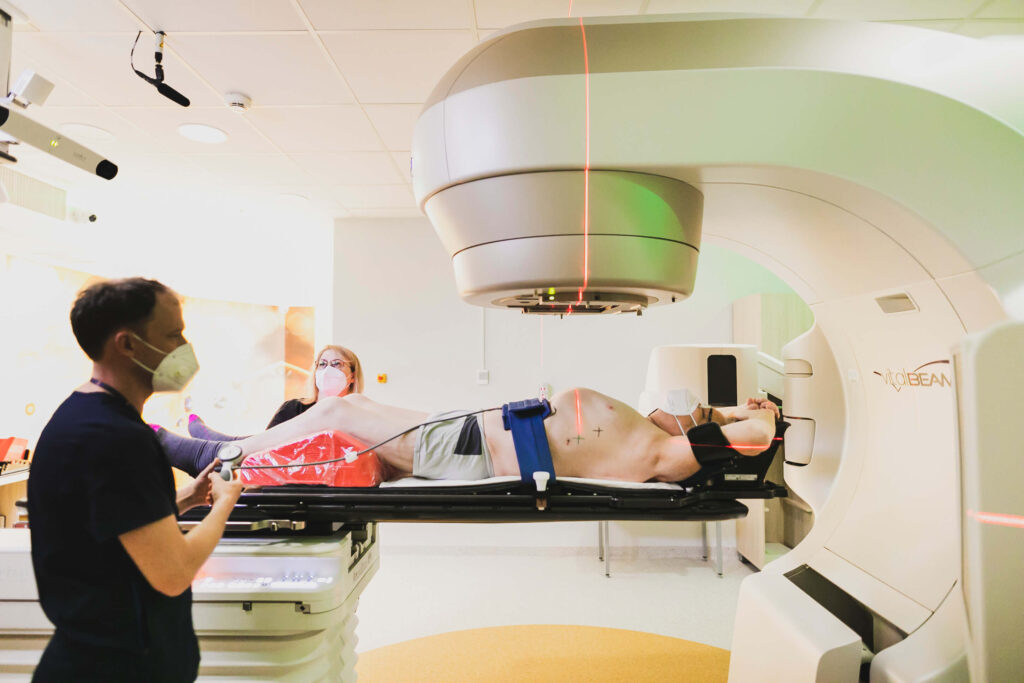Department of Neurooncology and Radiosurgery

Unique methods of treatment used:
Radiosurgery of multiple brain metastases
Stereotactic radiosurgery (SRS) is an effective treatment in patients with multiple brain metastases. Three decades of increasingly robust research have shown that SRS improves outcomes and reduces toxicity when it replaces whole brain radiation therapy (WBRT). At the Cancer Centre, this treatment has already been used by several hundred patients, and allowed to stop the neoplastic disease in the brain and reduce neurological symptoms. A team of doctors presents the results of this treatment at conventions in Poland and abroad, participating in the most prominent scientific meetings.
Stereotactic radiotherapy of metastases to the lymph nodes, lungs, liver, pancreas or soft tissues
Patients with a limited number of metastases can potentially be cured with ablative therapy for all active lesions. Stereotactic body radiation therapy (SBRT) is a non-invasive treatment option that has recently proven to be as effective and safe as surgery in the treatment of lung metastases, and more effective than previously used palliative radiotherapy, in treating several lesions spread throughout the body. At the Oncology Centre in Bydgoszcz, we have experience in the effective treatment of tumours of the prostate, liver, pancreas, lung and lymph nodes.

Radiosurgery of the spine
Given the success of radiosurgery in treating a variety of both malignant and benign intracranial tumours, there has been increasing interest in the use of high doses of conformal radiation to treat spinal injuries in this minimally invasive manner. Stereotactic radiosurgery of the spine relies on the precise delivery of high doses of ionizing radiation to tumours of the spine and spinal cord, reducing radiation exposure of normal surrounding structures. Its use in the treatment of spinal injuries was limited by the availability of effective technologies for localization of the lesion.
Radiosurgery of the spine is used to treat benign or malignant lesions of the spine, including primary tumours, metastases, meningiomas, neurofibromas, neuroblastomas, and vascular malformations. Since 2018, the heads of Neurosurgery Clinics from the entire region have been working with a team of experienced radio-oncologists to develop unique clinical experience in the field of spine radiosurgery; more than 200 patients have been successfully cured so far.
The Novalis radiosurgical system, located in the Oncology Centre, has unique and dedicated tools allowing for world-class radiosurgery. Additionally, the possibility of flexible fusions of PET images with MR and CT and the implementation of molecular imaging in radiosurgery allows for the creation of new possibilities, while close cooperation with the most experienced neurosurgeons allows to increase the effectiveness in the most difficult cases.
Radiosurgery of the spine offers a new and important alternative therapeutic method for the treatment of spinal tumours in patients who wish to avoid surgery, are medically inoperable, or are illegible for resection. It also allows for effective treatment of patients who have previously undergone irradiation, have lesions that cannot be managed by open surgical techniques or as a supplement to a surgical procedure. Radiosurgery of the spine allows many patients to avoid open surgery with even better clinical outcomes.
Radiosurgery with the ExacTrac system
The ExacTrac system achieves sub-millimetre precision through the accuracy of positioning and beam delivery monitoring. The Oncology Centre in Bydgoszcz is one of the first centres in the world to have the state-of-the-art radiosurgery system – ExacTrac Dynamic, which combines power and precision of the most modern beam tracking technologies. It enables highly precise procedures both inside and outside of the skull, e.g. prostate cancer. Revolutionary new infrared camera technology works in conjunction with real-time X-ray tracking, providing exceptional accuracy.

Radiosurgery and stereotaxic radiotherapy with the use of arches and intensive modulation – HybridArc
Novalis radiosurgery has the unique ability to constantly adapt the beam shape and allows the treatment of the most complex tumours while still achieving a steep dose reduction at the edge of the lesion. The HybridArc™ technique allows for an exceptionally exact match of the high dose to complex targets located in the brain or in the spine by using a high-resolution multi-leaf collimator. At the same time, by irradiating during the rotation of the device head and by adjusting the beam shape to the tumour in real time, we shorten the treatment time from hours to several minutes, improving the patient’s comfort.
Other Innovative Medical Techniques in the Department of Neurooncology and Radiosurgery
At the Innovative Medical Forum of the Oncology Centre, we are working on new solutions for our patients. Currently, we are developing the possibilities of radiosurgery treatment in combination with TTFields therapy, at the same time we are cooperating with the Department of Medical Genetics of the Oncology Centre, looking for unique genetic disorders increasing sensitivity to radiosurgery, and as part of the interdepartmental group of scientists at the CM UMK University (Emerging Field) we are developing treatment options using imaging with new radiotracers allowing for ultra-precise determination of the boundaries of the infiltration of brain tumours, such as e.g. glioblastoma multiforme.

Treatment with alternating electric field – TTFields
The device called TTFields is used in research at the Department of Neurooncology in the treatment of brain tumours. TTFields delivers low-intensity alternating electric fields through the skin and other tissues to the tumour. Preclinical studies have shown that, due to the size and shape of cancer cells, as they proliferate, TTFields displace electrically charged cellular elements in a cell that is dividing, disrupting their normal function and can lead to cell death. TTFields are a unique method of treating glioblastoma multiforme and other solid tumours, involving low intensity (~1–3 V/cm), medium frequency (100–300 kHz), alternating electric fields that act specifically on rapidly dividing cancer cells. TTFields are FDA approved at 200kHz for newly diagnosed and recurrent GBMs and 150kHz for malignant pleural mesothelioma. TTFields are credited with many cytotoxic mechanisms, including their effect on the microtubules and septin fibres of proliferating cancer cells, which disrupts mitosis and causes cell death, mitotic catastrophe, non-viable daughter cells, and cellular stress. TTFields also inhibit DNA damage repair, enhance replication stress, block cell migration and invasion, and enhance autophagy.
A synergistic effect between TTFields and radiotherapy was demonstrated in glioblastoma cell culture, possibly by inhibiting double-stranded DNA damage repair mechanisms, increased mitotic catastrophe, and decreased glioblastoma cell survival. This preclinical evidence motivates us to further clinical trials of this treatment method.

|
Coordinator
dr hab. n. med. Maciej Harat, prof. PBŚ
|

